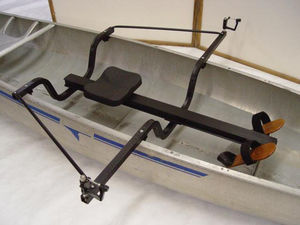
- Water sports
- Kayaking, Rowing, Canoeing
- Canoe seat
- Alden Rowing Shells
Canoe seat for rowing shellsadjustablesliding
Add to favorites
Compare this product
fo_shop_gate_exact_title
Characteristics
- Application domain
- canoe, for rowing shells
- Functionality
- adjustable, sliding
- Number of places
- 1-person
Description
The sliding rigger concept is not new. The primary advantage of this system is that it eliminates the effect of your torso weight shifting back and forth as it does with a sliding seat. This is particularly noticeable in shorter boats which will tend to "hobby-horse". The geometry of the sculling stroke is the same whether you have a sliding seat or a sliding rigger. One difference is the need to have a way to capture your lower back/butt for this is the point that connects the locomotion to the boat. We have a special padded seatplate for this function or the webbed recumbent seat used on our adaptive gear. Our footstretchers are still independently adjustable along the length of the 20" sliding carriage.
We first developed our sliding rigger in 1984. The first and largest commercial builder to incorporate our gear was Dave Emmer and his Skimmer catamaran. The international governing body of rowing (FISA) banned sliding riggers about the same time because their inherent speed advantage would immediately disenfranchise every rower that didn't have the system. It remains an interesting option for a vast number of hulls.
One drawback of the sliding rigger was determining how to install it as a canoe conversion. Because the sliding carriage must travel the whole length of the rail it is necessary to support the monorail at each end. Our Deck Plate and Stanchion kits are well suited for this in a number of stitch and glue plywood boats.
Catalogs
No catalogs are available for this product.
See all of Alden Rowing Shells‘s catalogs*Prices are pre-tax. They exclude delivery charges and customs duties and do not include additional charges for installation or activation options. Prices are indicative only and may vary by country, with changes to the cost of raw materials and exchange rates.






